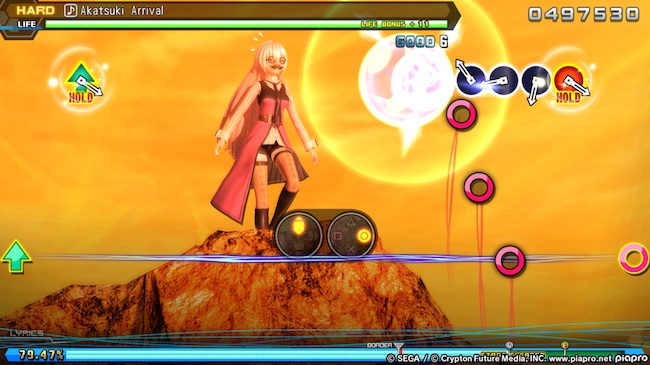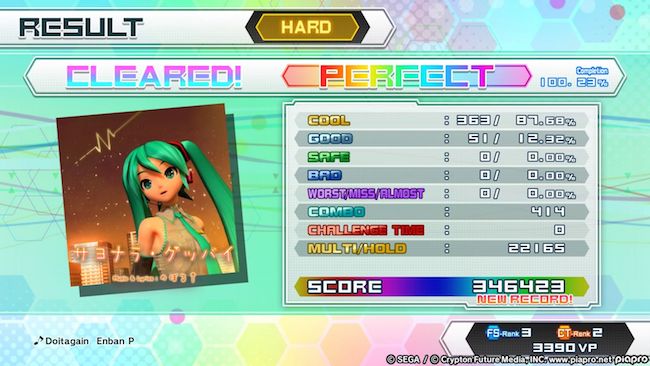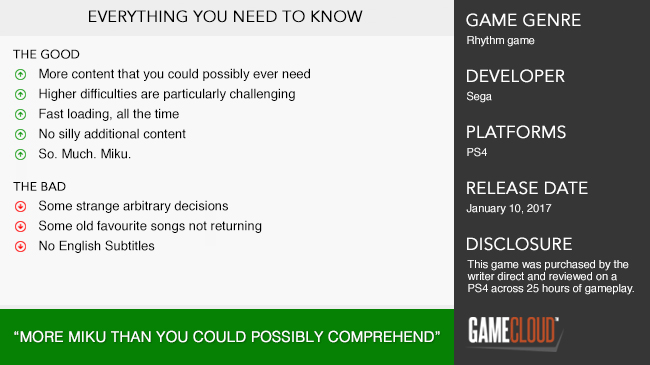
Amidst the mass of RPG and Puzzle games that I play, I reserve a special place for Rhythm games. Demanding quick finger-work and an innate sense of beat, these games expect much from the player, but always provide avenues by which you can practice and improve. Also, the music’s usually dang catchy. The Hatsune Miku: Project DIVA series has always managed to meet these expectations, and their latest release, Project DIVA Future Tone (PDFT) has brilliantly capped this all off with an extensive and challenging summary.
In case you’ve never encountered Hatsune Miku before, an explanation is vital: Miku and her friends are virtual music idols. Their songs are not produced by any singular entity but are created in full by the fanbase. As such, the songs vary massively, from cute pop songs about first love to dark metal tunes about betrayal and death. The Project DIVA games pull the best from this community pool and build a game around them. In particular, PDFT pulls the best from all of the Project DIVA games to fill its huge roster.

The rhythm game is relatively simple to describe: over a backdrop of a music video unique to the song, the four Playstation buttons fall into place, with the expectation that you would (naturally) press them in time with the beat. For as simple as it sounds, and proves to on Easy and Normal, the Hard and higher difficulties are intense and inherently produce many ‘in the zone’ moments that rhythm games are known for. On top of this, Hatsune Miku games tend to have unique additional elements that further complicate the gameplay.
Previous DIVA titles have simply offered a special note in which one ‘flicks’ the analog stick in any direction. PDFT has made a simple change to this system: the ‘flick’ is now a directional ‘arrow‘, pointing either left or right, and can also have a ‘hold’ version. This tiny change has improved these notes significantly for me. Whereas these were originally ‘filler segments’ offering no real challenge or purpose, they now complement particular parts of each tune.
The other major change to the base game of PDFT is the removal of the classic ‘hold’ notes as we know them. Rather than the game requiring you to hold a particular note for its full length, they are now entirely optional, and can also be held while pushing other buttons. This allows the player to make moment-by-moment judgements on whether to take on this extra challenge or not, to gain bonus points, turning yet another once-tedious element into something for the player to actively engage in.
That aside, it’s ultimately the same game that Miku fans have become familiar with over the past few years, with the same songs we’ve been enjoying. The song list is primarily made up of the old Project DIVA and Mirai titles, including some from the physical Arcade machines popular in Japan. All of the Arcade ones were new to me, and several of them have joined my list of favourites, so there’s still likely something new for you here if you’ve played the previous games.

The biggest selling point of PDFT is the sheer number of songs they’ve put together. The songs are provided in the form of two packs, Future Sound and Colorful Tone, although I can’t see why anyone wouldn’t be picking up both. Between the two of them, there are a whopping 224 songs available. It took me about 10 hours to play every song available on the Normal difficulty alone. Given the limited number of songs in their last release, Project DIVA X, I was delighted to have so much Miku goodness to enjoy.
The higher ranked songs also seem to offer a much harder challenge than seen before in these games. Personally, I was able to achieve at least an Excellent ranking on even the highest difficulty in all my previous time with Miku, but the 9-star and higher songs in PDFT thoroughly destroyed me. It’s going to require some commitment to take these songs down, but the idea of pushing through to achieve this goal is the kind of thing that got me into Miku games in the first place.
I was extremely impressed with how snappy and responsive all the menu work is, including the loading of songs. I’m not sure if this is solely because of the home-console nature of PDFT, but in my experience with hand-held Miku games, I have gotten accustomed to staring at the loading screen before songs, after songs, even loading the song list itself. PDFT has managed to cut these times down significantly thanks to the extra power of the console, reducing the downtime spent waiting between songs right down to near non-existent levels.
These load times are likely also improved by the removal of the silly ‘extra games’ that Project DIVA games have previously insisted on, such as buying items for your idol friends or literally spending time patting them on the head. These additional distractions have always been extremely unnecessary and pointless to me, reaching annoying when certain titles have insisted on you participating in them. PDFT has completely removed these; it is a straight arcade game and is exactly what I want from a rhythm game like this.

Despite all the positive elements, some strange arbitrary decisions seem to have been made, though these are mostly aesthetic. Some songs don’t feature any of the new ‘arrow’ notes at all, seemingly deliberately given the songs that do have them get a special icon indicating as such. Some songs are listed with an English translation of their title, and some aren’t. Nothing too terrible, but I couldn’t help but notice these inconsistencies.
As a fan of the series, I also noticed a few of my favourite songs didn’t return, like the amazingly catchy Kagerou Daze. I anticipate that these songs are likely coming in by way of DLC, in the tradition of the series so far. I’m in two minds about this: I share the commonly held distaste for paid DLC in any form, but I would love to have this game’s song list even further expanded, to cement this release as the epitome of current Miku games.
Perhaps the biggest negative of all is the loss of the English translation in the lyric subtitles from all songs. A staple of these titles since the second game, I have always enjoyed not just the tune, but the often poetic lyrics. Without them, I had no idea what my new favourites were even about for the entirety of my first play-through. There are solutions, of course, as I could easily look up the translations myself, and some simple research shows that the reason for their absence is to do with the need to have the original artist’s approval for any translations.
To wrap up on the positive note this game deserves, the game is as beautiful as expected, the music videos are fun to watch, and look amazing. Perhaps the only negative thing you could observe about the music videos are a few uncomfortable moments where the facial animation is stilted or sudden. These small moments are only a minor detractor from the overall clean experience.

The Project Diva series has always delivered consistently outstanding rhythm gaming, with various odd add-on content of differing quality. Project Diva Future Tone resolves this trend by giving us nothing but the quality rhythm gaming we love, and in absurd quantity. There’s really no reason for a fan of Miku and her games to not pick this up, unless the idea of repeat songs is entirely off-putting, but newcomers may want to try the demo before locking in the full amount. In the end, this is exactly the Hatsune Miku game I’ve wanted for the past couple years.











